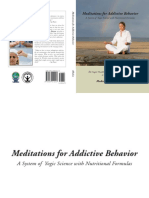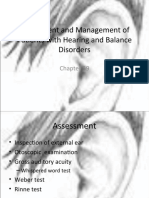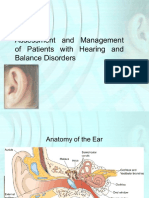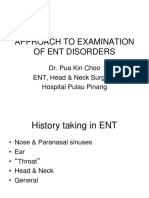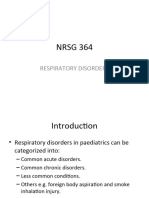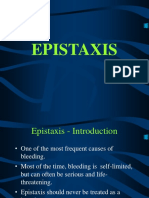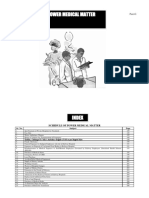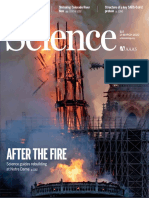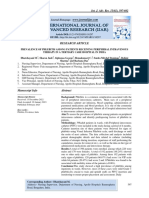Professional Documents
Culture Documents
Ent Badi PDF
Ent Badi PDF
Uploaded by
sandeep0 ratings0% found this document useful (0 votes)
28 views42 pagesThis document provides an overview of common ear, nose, and throat (ENT) problems in school-aged children. It discusses important ENT examination principles like evaluating for shortness of breath, hoarseness, difficulty swallowing, and stridor. Common otologic issues covered include otitis externa, tympanic membrane perforations, and vertigo. Nasal disorders like epistaxis and sinusitis are also reviewed. The document then examines facial, oral, and pharyngeal infections such as cellulitis, parotiditis, pharyngitis, and peritonsillar abscesses. It concludes with sections on airway obstruction and sleep problems.
Original Description:
Common Ear Nose & Throat (ENT) Problems in School Aged Population
Copyright
© © All Rights Reserved
Available Formats
PDF, TXT or read online from Scribd
Share this document
Did you find this document useful?
Is this content inappropriate?
Report this DocumentThis document provides an overview of common ear, nose, and throat (ENT) problems in school-aged children. It discusses important ENT examination principles like evaluating for shortness of breath, hoarseness, difficulty swallowing, and stridor. Common otologic issues covered include otitis externa, tympanic membrane perforations, and vertigo. Nasal disorders like epistaxis and sinusitis are also reviewed. The document then examines facial, oral, and pharyngeal infections such as cellulitis, parotiditis, pharyngitis, and peritonsillar abscesses. It concludes with sections on airway obstruction and sleep problems.
Copyright:
© All Rights Reserved
Available Formats
Download as PDF, TXT or read online from Scribd
Download as pdf or txt
0 ratings0% found this document useful (0 votes)
28 views42 pagesEnt Badi PDF
Ent Badi PDF
Uploaded by
sandeepThis document provides an overview of common ear, nose, and throat (ENT) problems in school-aged children. It discusses important ENT examination principles like evaluating for shortness of breath, hoarseness, difficulty swallowing, and stridor. Common otologic issues covered include otitis externa, tympanic membrane perforations, and vertigo. Nasal disorders like epistaxis and sinusitis are also reviewed. The document then examines facial, oral, and pharyngeal infections such as cellulitis, parotiditis, pharyngitis, and peritonsillar abscesses. It concludes with sections on airway obstruction and sleep problems.
Copyright:
© All Rights Reserved
Available Formats
Download as PDF, TXT or read online from Scribd
Download as pdf or txt
You are on page 1of 42
Common Ear Nose & Throat
(ENT) Problems in School Aged
Population
Arun Badi, MD, PhD, FAAP
Board Certified ENT and Sleep Medicine
Dallas ENT Group
Don’t forget these medical
maxims:
• ABCs – C also stands for Control the bleeder.
• Primum non nocere - First do no harm.
• Don’t forget that the ear, nose and throat are attached
to the rest of the body
• If they feel better, they heal better
• There is a reason they call them “vital” signs
• Chance favors the prepared mind
• Know your backup, have an evacuation plan
Golden Rules
• 4 principle questions of ENT history you must
always ask about.
• I call these the Golden 4
• Shortness of Breath
• Hoarseness (Or voice change)
• Difficulty Swallowing (Dysphagia). Odynophagia
(painful swallowing)
• Stridor (Noisy Breathing)
Overview
• Otologic Disorders
• Nasal Disorders
• Facial, Oral and Pharyngeal
Infections
• Airway Obstruction
Otologic Disorders
Anatomy
• Auricle
• Ear canal
• Tympanic
membrane
• Middle ear and
mastoid disorders
• Inner Ear
Traumatic Disorders of the Auricle
• Hematoma
- cartilaginous necrosis
- drain, antibiotics, bulky
ear dressing close follow
up
• Lacerations - single
layer closure, pick up
perichondrium, bulky ear
dressing
Use posterior auricular
block for anesthesia
Auricle
• Chondritis - Cellulitis ?
- infectious, difficult to treat
because poor blood supply,
cover S. Aureus and
pseudomonas
- extra care in diabetics
- inflammatory causes related
to seronegative arthritis at
times indistinguishable from
infection usually the ear lobe
is spared
Otitis Externa
• Infection and inflammation
caused by bacteria
(pseudomonas, staph), and
fungi
- treat with antibiotic-steroid
drops
- use wick for tight canals
- diabetics can get malignant
otitis externa (defined by the
presence of granulation
tissue)
Foreign Bodies in Ear Canal
• Usually put in by patient,
some bugs fly in
• kill bugs with mineral oil,
or lidocaine
• Emergency if it is organic
matter, insect or corrosive
chemical or battery.
• Otherwise can wait a
week or so.
Tympanic Membrane Perforation
• Hard to see – Hx of drainage
• Usually from middle ear pressure
secondary to fluid or barotrauma
• Sometimes from external trauma
• most heal uneventfully but all need
otology follow-up
• perfs with vertigo and facial nerve
involvement need immediate referral
• treat with antibiotics
• drops controversial but indicated for
purulent discharge (avoid gentamycin
drops)
Middle Ear
• Serous Otitis Media - Eustachian
tube dysfunction - treat with
decongestants, decompressive
maneuvers
• Otitis Media - infection of middle
ear effusion - viral and bacteria
• Mastoiditis - Venous connection
with brain, need aggressive
treatment (can lead to brain
abcess or meningitis)
Inner Ear
• peripheral vertigo (vestibulopathy)
BPV, labyrhinthitis
• - acute onset, no central signs, usually
young, horizontal nystagmus
The Nose
Epistaxis
Anterior
• 90% (Little’s Area) Kisselbach’s plexus -
usually children, young adults
Etiologies
• Trauma, epistaxis digitorum
• Winter Syndrome, Allergies
• Irritants - sprays
• Pregnancy
Epistaxis
Posterior
• 10% of all epistaxis - usually in the elderly
• Etiologies
– Coagulopathy
– Atherosclerosis
– Neoplasm
– Hypertension (debatable)
Epistaxis
Management
• Calm patient
• Topical vasoconstrictor (Afrin)
• Gown, mask, goggles
• Pain meds, Digital pressure
• Evacuate clots
• Identify source
Sinusitis
Orbital Infections
• Treatment
Sinusitis
acute - amoxil, septra
chronic - amoxil-clavulinic acid,
clindamycin, quinolones
decongestants, analgesia, heat
7th Nerve Palsy
• Most cases are idiopathic
- link to HSV
- Protect eye
Facial Infections
Sinusitis
• Signs and symptoms
- H/A, facial pain in sinus
distribution
- purulent yellow-green
rhinorrhea
- fever
- CT more sensitive than
plain films
• Causative Organisms
- gram positives and H. flu
(acute)
- anaerobes, gram neg
(chronic)
Facial Cellulitis
• Most common strept
and staph,
• Rarely H.Flu
• Can progress rapidly
Parotiditis
• Usually viral
-paramyxovirus
• Bacterial
- immunosuppressed
- associated with dehydration
- cover - Staph, anaerobes
Pharyngitis
• Allergies
• Irritants
-reflux, trauma, gases
• Viruses
- EBV, adenovirus
• Bacterial
-GABHS, mycoplasma, gonorrhea,
diptheria
Peritonsillar Abcess
• Complication of
suppurative tonsillitis
• Inferior - medial
displacement of
tonsil and uvula
• dysphagia, ear pain,
muffled voice, fever,
trismus
Epiglottitis
Clinical Picture
• Older children and adults
• decrease incidence in children
secondary to HIB vaccine
• Onset rapid, patients look toxic
• prefer to sit, muffled voice,
dysphagia, drooling,
restlessness
Epiglottitis
• Avoid agitation
• Direct visualization if patient allows
• soft tissue of neck
- thumb print, valecula sign
• Prepare for emergent airway, best achieved
in a controlled setting
• Unasyn, +/- steroids
Masticator - Parapharyngeal
Space Infection
• Infection of the lower
molars invade masticator
space
• Swelling, pain fever,
TRISMUS
• Treatment
IV antibiotics (PCN or
Clindamycin)
ENT admission
Angioedema
• Ocassionally life
threatening
• Heriditary and related
to ACE inhibitors
• Antihistamines,
steroids and doxepin
Airway Obstruction
• Aphonia - complete upper airway
• Stridor - incomplete upper airway
• Wheezing - incomplete lower airway
• Loss of breath sounds- complete lower
airway
Foreign Body Airway
• Heimlich Heimlich
• Heimlich
• Heimlich
• Heimlich
Word about Sleep
• Problems w QUANTITY of sleep
• Insufficient Sleep
• Insomnia
• Problems w QUALITY of sleep
• Apnea
• Sleep Walking, Sleep Talking, Bed Wetting
• Narcolepsy
Questions and Answers
You might also like
- EBook - Meditations For Addictive Behavior - Sec - PDFDocument41 pagesEBook - Meditations For Addictive Behavior - Sec - PDFMarcela Romero100% (6)
- Your Dream Body Come TrueDocument25 pagesYour Dream Body Come TruePatria DavidNo ratings yet
- Operation and Maintenance Manual Shoptek ST45, ST55 & ST75 Rev 01Document76 pagesOperation and Maintenance Manual Shoptek ST45, ST55 & ST75 Rev 01Andres Paul (paultgt)67% (3)
- Rev Manual DCF & Cert Page For Muns & CCs - PY 2018 - 2018 ProjPop - Updated 011619Document12 pagesRev Manual DCF & Cert Page For Muns & CCs - PY 2018 - 2018 ProjPop - Updated 011619Sheena SilorioNo ratings yet
- ENT Emergencies: Stanford University Division of Emergency MedicineDocument35 pagesENT Emergencies: Stanford University Division of Emergency Medicineitho23No ratings yet
- P 3 The Upper Respiratory Tract 2Document61 pagesP 3 The Upper Respiratory Tract 2Christelle CilliersNo ratings yet
- Assessment and Management of Patients With Hearing and Balance Disorders WebDocument36 pagesAssessment and Management of Patients With Hearing and Balance Disorders Webmalinda0% (1)
- Otitis Media: Prepared By: - Priyanka ThapaDocument38 pagesOtitis Media: Prepared By: - Priyanka ThapaKalo kajiNo ratings yet
- Diseases of The EarDocument48 pagesDiseases of The Earabela_amulu100% (1)
- Dr. Fifin Pradina Duhitatrissari SP - THT-KL FK Unisma/Rsi UnismaDocument49 pagesDr. Fifin Pradina Duhitatrissari SP - THT-KL FK Unisma/Rsi Unisma216-104Yuda PerdanaNo ratings yet
- THEEARDocument9 pagesTHEEARapi-3822433No ratings yet
- 2.ent EmergenciesDocument54 pages2.ent Emergenciesmesay zelekeNo ratings yet
- Respiratory Disorders in PediatricsDocument11 pagesRespiratory Disorders in PediatricsMateo Geoff100% (1)
- ENT Emergencies LectureDocument29 pagesENT Emergencies LectureThea Bertea100% (1)
- Alvarillo, Dana Mappatao, Kam Siervo, ChristineDocument44 pagesAlvarillo, Dana Mappatao, Kam Siervo, ChristineHana Sanchez AlobaidanNo ratings yet
- Non-Suppurative Otitis MediaDocument20 pagesNon-Suppurative Otitis MediasaymynamesNo ratings yet
- Adeno TonsillitisDocument65 pagesAdeno TonsillitisdrtpkNo ratings yet
- Common ENT Conditions PresentationDocument60 pagesCommon ENT Conditions PresentationMICHAEL SAKALANo ratings yet
- Acute Sinusitis DmimsuDocument66 pagesAcute Sinusitis DmimsuSharnie JoNo ratings yet
- Throat PowerpointDocument29 pagesThroat Powerpointminci sensei100% (8)
- Ears DisordersDocument112 pagesEars DisordersRenie Serrano100% (1)
- 1.3 EarDocument28 pages1.3 EarStaphy AuNo ratings yet
- ENT Emergency: James Paul O'NeillDocument43 pagesENT Emergency: James Paul O'NeillkylieverNo ratings yet
- OtitisanDocument54 pagesOtitisanmagreaNo ratings yet
- Common ENT ProblemsDocument41 pagesCommon ENT ProblemsMohamed GhabrunNo ratings yet
- Lecture 2.1-External Ear Disorders-Ashadi Prasetyo (2017) PDFDocument71 pagesLecture 2.1-External Ear Disorders-Ashadi Prasetyo (2017) PDFAnonymous XFDJfsGviNo ratings yet
- BHN Kuliah Traumatology English Class QP-2003 BaruDocument168 pagesBHN Kuliah Traumatology English Class QP-2003 BaruazifadewiatasyaNo ratings yet
- Sinusitis: Rhonda Lesniak Primary Care IIDocument33 pagesSinusitis: Rhonda Lesniak Primary Care IIshyamashaNo ratings yet
- Case EarDocument33 pagesCase EarMegan ShanzuNo ratings yet
- 4 EpistaxisDocument51 pages4 Epistaxisabhikothari30No ratings yet
- Diagnosis of Ent Disorders You Make The CallDocument137 pagesDiagnosis of Ent Disorders You Make The Callsaifsaffa2No ratings yet
- Curs FaringeDocument49 pagesCurs FaringeAdi SitaruNo ratings yet
- Upper Respiratory Tract InfectionsDocument41 pagesUpper Respiratory Tract Infectionsmsichiliinnocent7No ratings yet
- Eye, Ear, Nose, and Throat Infections: Nenad PandakDocument68 pagesEye, Ear, Nose, and Throat Infections: Nenad PandakDiana TurcanNo ratings yet
- Otitis Media With Effusion: Shixun Zhong PH.DDocument31 pagesOtitis Media With Effusion: Shixun Zhong PH.DsuciNo ratings yet
- Diseasesofexternalear 1Document86 pagesDiseasesofexternalear 1Nitin Sharma100% (1)
- Management of Common Ear Nose & Throat Problems: Professor Khalid H MahidaDocument65 pagesManagement of Common Ear Nose & Throat Problems: Professor Khalid H MahidaFurqan MirzaNo ratings yet
- The Child With Respiratory DysfunctionDocument91 pagesThe Child With Respiratory DysfunctionSerbanNo ratings yet
- Approach To Examination of ENT DisordersDocument39 pagesApproach To Examination of ENT DisordersMohammad SaifullahNo ratings yet
- Acute Suppurative Otitis MediaDocument20 pagesAcute Suppurative Otitis MediaNidya PutriNo ratings yet
- ENT Urgencies / Emergencies in Primary CareDocument55 pagesENT Urgencies / Emergencies in Primary CareDr_Aan_ArdiansyahNo ratings yet
- NRSG 364 - Respiratory DisordersDocument65 pagesNRSG 364 - Respiratory DisordersJoanNo ratings yet
- Kitty ActonDocument25 pagesKitty ActonSarina PromthongNo ratings yet
- Acute Suppurative Otitis MediaDocument20 pagesAcute Suppurative Otitis MediasuciNo ratings yet
- 18 Head and NeckDocument23 pages18 Head and NeckMahmoud AbuAwadNo ratings yet
- Ent Case 2Document29 pagesEnt Case 2Trina CardonaNo ratings yet
- Ear Disorders PDFDocument24 pagesEar Disorders PDFRaymund Christopher Dela PeñaNo ratings yet
- Otitis Media and InternaDocument4 pagesOtitis Media and Internadina harumaNo ratings yet
- Adeno Tonsillitis: Dr. A. Karunagaran, M.S. D.L.ODocument148 pagesAdeno Tonsillitis: Dr. A. Karunagaran, M.S. D.L.ODrravikumar BhandariNo ratings yet
- EpistaxisDocument33 pagesEpistaxispaulyn ramosNo ratings yet
- Chapter 22 RespiratoryDocument33 pagesChapter 22 RespiratoryJessNo ratings yet
- Nursing Care of High Risk InfantDocument48 pagesNursing Care of High Risk InfantDianne Rose AgliamNo ratings yet
- Presenters: Eko Nugroho Fariz Afristya Raymond Win Ruli Aulia Stacy GabriellaDocument48 pagesPresenters: Eko Nugroho Fariz Afristya Raymond Win Ruli Aulia Stacy GabriellaYosephine ninaNo ratings yet
- ARIs CME2Document50 pagesARIs CME2JunaidahMubarakAliNo ratings yet
- Diseases of External EarDocument25 pagesDiseases of External Earjulie_eyna0% (1)
- The Ear and It's DisordersDocument104 pagesThe Ear and It's DisordersAyaBasilioNo ratings yet
- ENT Lectures 1Document123 pagesENT Lectures 1lxnalexander100% (1)
- Chronic Suppurative Otitis Media Chronic Suppurative Otitis MediaDocument34 pagesChronic Suppurative Otitis Media Chronic Suppurative Otitis MediaMariappan RdNo ratings yet
- Acute Otitis Media (Dr. Ismail 10-11-14)Document40 pagesAcute Otitis Media (Dr. Ismail 10-11-14)dr arshadNo ratings yet
- EntDocument105 pagesEntNikhil KumarNo ratings yet
- OHNS--Otolaryngology; Head and Neck surgery: pocket field guideFrom EverandOHNS--Otolaryngology; Head and Neck surgery: pocket field guideNo ratings yet
- EcstasyDocument27 pagesEcstasyDan GajewskiNo ratings yet
- Pathological FracturesDocument48 pagesPathological FracturesHafidah RakhmatinaNo ratings yet
- Early Orthodontic TreatmentDocument1 pageEarly Orthodontic TreatmentSWATINo ratings yet
- Naskah Publikasi (Yuli Kurniasih)Document11 pagesNaskah Publikasi (Yuli Kurniasih)Dadang UbaedillahNo ratings yet
- Evidence-Based Guidelines On The Therapeutic Use of Repetitive Transcranial Magnetic StimulationDocument57 pagesEvidence-Based Guidelines On The Therapeutic Use of Repetitive Transcranial Magnetic StimulationMiguel100% (1)
- Bethany Bealko Resume WestvaDocument2 pagesBethany Bealko Resume Westvaapi-272860000No ratings yet
- UTIDocument53 pagesUTIMimi Suhaini SudinNo ratings yet
- Birth Salt Bio ChemicDocument14 pagesBirth Salt Bio ChemicHomoeopath Aamir Saleem0% (1)
- PAK0193 Pakistan Punjab TVET ProposalDocument45 pagesPAK0193 Pakistan Punjab TVET Proposalzeeshanali1No ratings yet
- 6SOP Medical Matter HindiDocument39 pages6SOP Medical Matter HindiManas RawatNo ratings yet
- Procedure: Administering An Intradermal Injection For Skin TestDocument3 pagesProcedure: Administering An Intradermal Injection For Skin TestSofia AmistosoNo ratings yet
- Online CatalogueDocument21 pagesOnline CatalogueAsishmukundan AsishNo ratings yet
- US vs. Dennis Nobbe: Government Motion To AppealDocument15 pagesUS vs. Dennis Nobbe: Government Motion To AppealTony OrtegaNo ratings yet
- PathologyDocument36 pagesPathologySayeed KhanNo ratings yet
- Quality Management in The Imaging Sciences 5th Edition Papp Test BankDocument35 pagesQuality Management in The Imaging Sciences 5th Edition Papp Test Bankmisdateholinessaubzt6100% (28)
- When Teens Don't Get Enough Sleep - Sleep Deprivation Effects - Child Mind Institute PDFDocument10 pagesWhen Teens Don't Get Enough Sleep - Sleep Deprivation Effects - Child Mind Institute PDFEffa MohamadNo ratings yet
- Science - 13 March 2020 PDFDocument149 pagesScience - 13 March 2020 PDFOscar AvilaNo ratings yet
- Biology - Extended Essay SnickereensDocument28 pagesBiology - Extended Essay Snickereenshello helloNo ratings yet
- Unit 8 The Vital Functions (I)Document19 pagesUnit 8 The Vital Functions (I)PedroSerranoMartinezNo ratings yet
- 1 s2.0 S0886335018305959 Main PDFDocument7 pages1 s2.0 S0886335018305959 Main PDFtiaraleshaNo ratings yet
- Adinarayana CivilEngineer ResumeDocument3 pagesAdinarayana CivilEngineer ResumeDivya ChivikiNo ratings yet
- Prevalence of Phlebitis Among Patients Receiving Peripheral Intravenous Therapy in A Tertiary Care Hospital in IndiaDocument6 pagesPrevalence of Phlebitis Among Patients Receiving Peripheral Intravenous Therapy in A Tertiary Care Hospital in IndiaIJAR JOURNALNo ratings yet
- Nutrition Exam 2 Review 2015Document3 pagesNutrition Exam 2 Review 2015WesleyNo ratings yet
- Basic Ethical Principles 1 StewardshipDocument8 pagesBasic Ethical Principles 1 StewardshipGlizzle MacaraegNo ratings yet
- gtbr14 Main Text PDFDocument134 pagesgtbr14 Main Text PDFAnonymous fqa7PO8oNo ratings yet
- Covid-19 Video Script: Draft v0.1Document8 pagesCovid-19 Video Script: Draft v0.1Invaders_OfficialNo ratings yet
